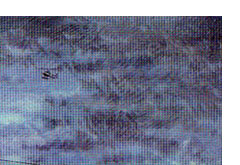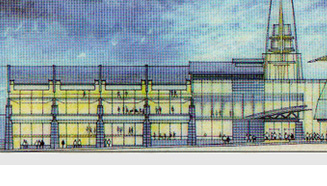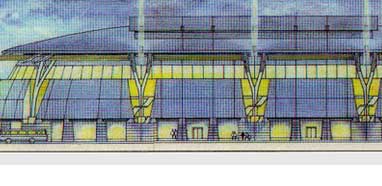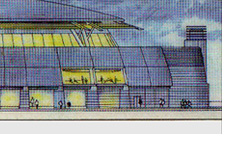|
|
Proposals for the
National Ice Centre were unveiled on the 21st
October 1996, which
revealed a major landmark building of local, national and international
importance, and one that Nottingham sees as its flagship building
entering the New Millennium.
In September 1998
Nottingham City Council was awarded £22.5 million by the English Sports
Council through the Lottery Sports Fund towards its building of the new
£36 million Centre. With the exceptions of the new National Stadium
development at Wembley, and the 2002 Commonwealth Games Stadium in
Manchester, the Ice Centre project has attracted the largest single
Lottery capital grant from Sport England.
These funds have
enabled Nottingham to press ahead with the development of the twin-rinked
complex on the site of Nottingham's existing Ice
Stadium and neighbouring land.
Work on Phase 1 of the development, building the 7500 seater main arena,
began in the Summer of 1998, with completion scheduled for Spring 2000.
Shortly after the public opening of the main arena, Phase 2 will begin.
This will basically comprise of the demolition of the existing Ice
Stadium buiilding, and the completion of the structure which will house
the second 'community' rink. Phase 2 will also include the creation of a
'Public Square' fronting Bellar Gate. The complex is due for completion
in 2001.
The Design &
Property Services Department at Nottingham City Council has been
responsible for the design of the Centre since its conception back in
September 1995.The City Council has carried out an extensive
consultation exercise during the design development of the scheme. This
exercise has drawn on a wealth of experience from partners at local
level, as well as working with the sports bodies such as the British Ice
Hockey Association (BIHA) and the National Ice Skating Association (NISA),
practitioners and consultants. Further, the people of Nottingham are
fully committed to the scheme and have responded very enthusiastically
to the exhaustive consultations carried out.
A number of
specialist consultants and advisers involved in the scheme development
include, among a host of others; Gleeds as project managers and cost
consultants, and Ove Arup as structural / mechanical & electrical
engineers. Architects & Urban Designers Faulkner Browns*, with their
vast experience in leisure buildings, have now taken on the role of ice
/ refrigeration specialists following their earlier involvement as specialist
architectural advisers. Laing Construction, who are the main
contractors, have brought a considerable amount of experience and
knowledge to the project, and are progressing very rapidly on site to
meet the two phased building programme.
A great amount has
been achieved in the relatively short period of time since the Lottery
award was made. This goes in no small part to the efforts that all
members of the team have played and continue to play. From the public
users of the existing Stadium, to the construction design team and
client organisations, all have shown tremendous commitment and teamwork
to this exciting project, especially over recent months.
Financial,
operational and aesthetic issues are inter-dependant; one affects, and
is affected by the other. The whole process is a cyclical one. Working
within a set cost plan, any changes, which are inevitable during the
development, and construction stage of any project, have reflections in
the overall building cost. Reasons behind these changes, be they
operational, aesthetic or cost related, must be carefully considered and
thoroughly analysed. Good communication and effective team playing are
therefore essential, and have played a major part in the rapid progress
of the current status of the Centre's development.
The City Council is
investing £3.75 million into the development of the Centre. A further
grant of almost £1 million has come from English Partnerships, the
Government's regeneration agency, to help pay for site preparation works
prior to construction. The European Union has also awarded £3 million
towards the cost of creating the public square in front of the Centre
and improving the approaches to the complex.
A charitable trust -
whose members include Nottingham's own Olympic ice dance champions Jayne
Torvill and Christopher Dean - has been established to spearhead the
development of the new centre and to ultimately serve as a board of
directors of the facility when it opens.
The operator of the
Centre will be Nottingham Ice Centre Ltd, the company which has managed
the old Ice Stadium since work on building the new venue began.
portfolio
slideshow preview
CREDITS
Designers
Architecture:
Nottingham City Council -
Design & Property Services
Quantity Surveying:
Nottingham City Council
- Design & Property Services
Civil Structural, Mechanical & Electrical:
Arup Associates
Specialist Architectural Advisor:
Faulkner
Brown
Ice Engineering:
Devin Consulting
Acoustic Engineers:
Sound Research
Laboratories
Sound System:
Peter Mapp & Associates
Fire Engineering:
Fire Safety Engineering
Consultants
Archaeology & Exhumation:
John Samuels
Archaeological Consultants
Contractors
Main Contractor:
Laing Limited
Mechanical & Electrical Design & Installation:
Haden Young
Ice Installation:
CIMCO
Dashers:
Swedish Rolls
Seating:
Hussey
Arena Lighting:
Musco
Sound System:
Creative Technical Systems
Structure:
Westbury Tubular Structures
Envelope:
Kelsey Roofing, Trent Concrete,
Howells Glazing, SLW
Precast concrete:
Tarmac, Richard Lees
Doors:
Leaderflush, Martin Roberts
Fitting out:
Caliba, Gibson Lea
Kitchen Equipment:
Garners
|
|
|
A
CHRONOLOGICAL HISTORY |
|
SEPTEMBER
1995 |
- Nottingham
City Council announces its intention to prepare a National
Lottery bid for funding towards the construction of a new
two-rink ice centre / concert venue - at an estimated cost of
£13 million - to replace Nottingham's existing Ice Stadium,
which opened in 1939. Several sites are being considered for
the 'centre of artistic excellence', including the existing
site off Lower Parliament Street.
|
|
NOVEMBER
1995 |
- Feasibility
studies presented to a meeting of Council officials and Ice
Stadium directors show the existing site is capable of
accommodating the new centre.
|
|
FEBRUARY
1996 |
- Plans
for the new centre, designed by the Council's in-house design
division, are unveiled at the Ice Stadium before
representatives of the press and media and ice sports
governing bodies. The plans envisage a main rink surrounded by
seating for 7,500 spectators
- (and up
to 9,500 for concerts) and a community rink for public skating
and practice, with the main Arena pad capable of being covered
to provide a major indoor concert / exhibition venue.
|
|
MARCH
1996 |
- Nottingham's
1984 Olympic ice dance champions Jayne Torvill and Christopher
Dean, who have pledged to hold summer training schools at the
new centre, visit the Ice Stadium to lend their support to the
project.
|
|
APRIL
1996 |
- The
scheme is granted outline planning permission. Nottingham City
Council Chief Executive, Ted Cantle presents the Lottery
Sports Fund bid - endorsed in a foreword by Torvill and Dean -
to the English Sports Council in London. A 150-page brochure
is submitted in support of the application. The estimated cost
of the scheme is revised to £30 million.
|
|
OCTOBER
1996 |
- A
scale model of the Ice Centre goes on public display in
Nottingham.
|
|
NOVEMBER
1996 |
- The
British Olympic Association declares its support for Lottery
funding being made available for the Nottingham Ice Centre
project.
|
|
DECEMBER
1996 |
- The
English Sports Council approves in
principle Nottingham's Lottery Sports Fund application.
|
|
APRIL
1997
|
- Gleeds
Management Services are appointed as project managers.
|
|
MAY
1997 |
- The
scale model of the Ice Centre is selected for display at the
Royal Academy of Arts 229th Summer Exhibition in London.
|
|
JUNE
1997 |
- Ove
Arup
& Partners are appointed as engineers for the new centre.
|
|
JULY
1997 |
- Demolition
work begins on the site of the new centre. The first phase of
work involves knocking down a former warehouse on the opposite
side of Barker Gate to the existing Ice Stadium. This part of
the site is earmarked for the 7,500 capacity main Arena of the
two-rink complex.
|
|
SEPTEMBER
1997 |
- The
City Council announces a change in the way it plans to attract
part of the funding for the new centre. Rather than appoint a
private sector partner as its preferred choice to run the
centre in return for a capital investment of at least £3.75
million, the Council plans to establish a charitable company
to borrow the money and appoint a facility manager later.
|
|
OCTOBER
1997 |
- The
City Council submits its final award application to the
English Sports Council. The estimated cost of the scheme is
revised to £36 million. Ice sports governing bodies, the
Nottingham-based British Ice Hockey Association and the
National Ice Skating Association, pledge to bring world-class
events to the new centre.
|
|
FEBRUARY
1998 |
- The
English Sports Council makes a final award of £22,496,600 to
the project from the Lottery Sports Fund. The scheme is
granted full planning permission.
|
|
APRIL
1998 |
- Road
works
begin to prepare junctions around the development site for new
traffic routes and to enable underground pipes and power
cables to be diverted. Work is expected to take up to six
months to complete.
|
|
MAY
1998 |
- Laing
Ltd. is appointed as the City Council's preferred contractor
for constructing the new Ice Centre following the formal
tendering exercise.
- A
group of trustees is appointed to spearhead the development of
the project. The trust will oversee work to prepare for the
opening of the new centre and will ultimately serve as a board
of directors of the facility once it is up and running in
2001.
|
|
JUNE
1998 |
- Specialist
contractors begin the task of exhuming remains from a 19th
Century graveyard beneath a car park on the site of the new
centre, in order to clear the way for the start of
construction work.
- The
City Council gets the go-ahead to buy land and buildings on
the development site when its compulsory purchase orders on
the existing Ice Stadium, its surrounds and the New Cheers
restaurant opposite, are confirmed by the Secretary of State
for the Environment.
|
|
JULY
1998 |
- English
Partnerships announces it is to invest £980,000 in the new
centre. The money will go towards work to divert services
including electricity, water and gas around the development
site.
|
|
AUGUST
1998 |
- Ice
dance legends Jayne Torvill and Christopher Dean agree to join
the group of trustees shaping the development of the new
centre.
- The
City Council acquires the New Cheers Restaurant building,
which it needs to demolish to make way for the Arena of the
centre. The Old Cricket Players pub is retained.
- The
City Council appoints Nottingham Ice Centre Ltd to take over
the management of the existing Ice Stadium after buying the
lease from the Nottingham Ice Stadium Company Ltd. The Foyer
is demolished and a new entrance is opened on the opposite
side of the building to facilitate construction work on the
new centre. Facilities previously in the foyer are relocated
to other parts of the stadium.
- Barker
Gate closes one week ahead of schedule. New signalised road
junctions and traffic routes to accommodate the closure come
into effect.
|
|
SEPTEMBER
1998 |
- Nottingham
City Council and the English Sports Council sign the £22.5
million Lottery Sports Fund award contract.
- Jayne
Torvill attends her first meeting of the Ice Centre Trust,
whose members are shown around the construction site by
contractors Laing Ltd.
|
|
OCTOBER
1998 |
- An
operator for the new ice centre is appointed. Nottingham Ice
Centre Ltd, the management company appointed by the City
Council to run the existing Ice Stadium, is given the go-ahead
to run the new facility for a three-year period covering
construction, commissioning and completion.
- A
planning application is submitted to convert Barker Gate
House, a multi-storey office block adjoining the Ice Centre
site, into a hotel.
|
|
DECEMBER
1998 |
- Building
work on the Arena begins with the construction of the steel
structure.
|
|
JANUARY
1999 |
- The
ice centre unveils its logo and a new name - The National Ice
Centre Nottingham.
|
|
FEBRUARY
1999 |
- The
British Ice Hockey Association, the national governing body of
the sport, relocates its headquarters to temporary offices in
Nottingham ahead of its permanent move to the Ice Centre.
|
|
MARCH
1999 |
- The
first roof support - an 80-metre-long 106-tonne double truss -
is lifted 20 metres off the ground and fixed to the steel
frame of the Ice Centre's Arena.
|
|
JULY
1999 |
- Rene
Fasel, President of the International Ice Hockey Federation,
the sport's world governing body, tours the Ice Centre site
during a visit to mark the re-launch of Nottingham-based
British Ice Hockey Association under its new name of Ice
Hockey UK.
- Nottingham
City Council is awarded its biggest-ever European grant, just
over £4million, to create a major new public square in front
of the Ice Centre and breathe fresh life into the economy and
environment of the neighbouring Lace Market area.
|
|
AUGUST
1999 |
- Plans
are announce to create Britain's first academy of ice sports
at the Ice Centre. A coaching school will be established to
spearhead the development of figure and speed skating, ice
dancing and ice hockey from grass roots level through to World
and Olympic competition standard.
|
|
SEPTEMBER
1999 |
- Shirley
Bassey is confirmed as one of the first major performers to
appear at the Arena. Her concert, scheduled for 19 May 2000,
is the first at the Arena to go on sale.
|
|
OCTOBER
1999 |
- Work
begins to install more than 11 miles of ice-making pipes
underneath the Arena rink. The job of removing 34 miles of
scaffolding around the development also gets under way.
|
|
NOVEMBER
1999 |
- A
project progress report reveals the National Ice Centre is
being built mainly by Nottingham people and firms. Some 75% of
the 200 workers on site are local, as are 18 of the 21
management staff from contractors Laing. By the project's end,
it's estimated that construction work worth £15 million -
more than half the cost of construction - will have been
carried out by local firms, representing a massive boost to
the local economy.
|
|
DECEMBER
1999 |
- Former
England footballer and now Chairman of Sport England, Trevor
Brooking, sees work on Nottingham's National Ice Centre in
progress. Visiting the city for a Sport England regional
assembly, Mr. Brooking and fellow delegates tour the
construction site. With the exceptions of the new National
Stadium development at Wembley and 2002 Commonwealth Games
stadium in Manchester, the Ice Centre has attracted the
largest single Lottery capital grant from Sport England.
- A
rare saxon jug known to be at least 1,100 years old, unearthed
in July 1998 during excavations for the new centre, goes on
display at Nottingham Castle Museum. Experts say the discovery
provides new evidence of an important settlement existing in
the city in the 8th century.
- Simply
Red will perform the first concert at the centre's Arena on 29
April 2000, it is announced.
|
|
JANUARY
2000
|
- Announcement
of Paul Weller concert at the Arena on 5 may 2000. Tickets go
on sale priced £23.50
|
|
FEBRUARY
2000
|
- The
Ice Centre is featured on BBC1's Midweek Lottery draw
programme UK2000. Andrew Hallam from Nottingham, and Eve
Bentley, Britain's sole ice dance representatives in the
forthcoming World Junior Ice Skating Championships in Germany,
press the button to start the draw.
|
|
MARCH
2000
|
- It's
spring, but the temperatures tumble inside the Arena as around
10,000 gallons of water is frozen to create the first
Olympic-sized ice pad. Local schools and colleges are invited
to free skating sessions on the eve of the rink opening for
public skating.
|
|
APRIL
2000
|
- The first
public skating session at the Arena is declared open by
Nottingham-born former Olympic ice dance champion Jayne
Torvill. Thousands of people flock to the venue to skate and
go on free guided tours of the building.
- Simply
Red perform the first concert at the Arena to a sell-out
crowd. On stage, the band's front man, Mick Hucknall, hails
the new venue a "wonderful place".
- Demolition
work begins on Nottingham's old Ice Stadium to make way for
the construction of the second, community ice rink and the
creation of a major outdoor public square fronting the new
centre.
|
|
MAY
2000
|
- Minister
for Sport Kate Hoey unveils a plaque at the Ice Centre marking
the opening of the Arena and the completion of the first phase
of the complex.
|
|
JUNE
2000
|
-
A
rededication service to lay to rest the remains exhumed from
the former graveyard beneath the Ice Centre site is held at
Nottingham's Southern cemetery at Wilford Hill, where the
remains were re-interred.
|
|
JULY
2000
|
- Plans are
announced to convert a former warehouse near the Ice Centre
into a temporary training rink pending completion of work to
build the centre's second permanent ice pad. The move is
designed to meet a surge in demand for tuition.
- The first
roof truss above the second, public pad is lifted into place.
|
|
SEPTEMBER
2000
|
- The
Ice Centre's resident ice hockey team the Nottingham Panthers,
play their first match in the Arena, beating the London
Knights 2-1 in the Benson & Hedges Cup qualifying round.
|
|
OCTOBER
2000
|
- The
Ice Centre opens the 'Ice Box', a temporary training rink
housed in a former cold store five minutes walk from the
Arena, pending the completion of work to build the centre's
second permanent ice pad.
|
|
NOVEMBER
2000
|
- The
Arena hosts the annual fund-raising evening for the BBC's
Children in Need Appeal in the East Midlands.
|
|
DECEMBER
2000
|
-
The
Arena is confirmed as the venue for the end-of-season
Superleague ice hockey play-off finals.
|
|
MAY 2001
|
|
|














![]() | Copyright © 2010
| Copyright © 2010